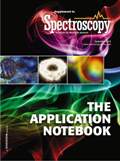Analysis of Drug Eluting Stent Coating Solutions Using FT-NIR Spectroscopy
Application Notebook
A drug-eluting stent (DES) is an expandable metal alloy framework placed into narrowed coronary arteries that slowly releases a drug coating to treat atherosclerosis. Production of DES is a labor-intensive batch process that requires very tight control. Fourier Transform Near-InfraRed spectroscopy (FT-NIR) is an efficient technique to perform accurate quantification of the different components in DES coating solutions.
Sacha Bonenfant and Frédéric Despagne, ABB Analytical
A drug-eluting stent (DES) is an expandable metal alloy framework placed into narrowed coronary arteries that slowly releases a drug coating to treat atherosclerosis. Production of DES is a labor-intensive batch process that requires very tight control. Fourier Transform Near-InfraRed spectroscopy (FT-NIR) is an efficient technique to perform accurate quantification of the different components in DES coating solutions.
Coronary artery disease is the leading cause of death in the developed world. It is caused by the gradual deposition of lipid and cholesterol plaques on the inner layer of the coronary arteries, leading to their hardening. Since the 1980s interventional cardiologists have developed DES using elaborate metal mesh-like design with a coating made of biostable polymer matrix that holds and releases an encapsulated active ingredient by diffusion into arterial walls.
Quantification of coating solution components using liquid chromatography (HPLC) is a time-consuming approach that requires preparation of column, sample and standards, and is using costly solvents. We present an application of FT-NIR as a fast and non-destructive alternative technology that can be operated by an operator without analytical background.
Experimental Conditions
Components of two coating solutions including biostable polymers (BP1, BP2), solvents (S1, S2, S3, S4) and the immunosuppressant everolimus (API) were analysed. Synthetic sets comprising samples with varying component concentrations were gravimetrically prepared for calibration of the FT-NIR spectrometer. Solution 1: BP1/S1/S2 (15 samples). Solution 2: API /BP2/S3/S4 (17 samples).
The %weight for each component was used as a reference value. For everolimus, the actual content was measured with HPLC and those values were used to calibrate the spectrometer equipped with a vial sampling accessory. A reference spectrum was first recorded in open beam condition. Each sample was then transferred with a pipette to a 1 mL disposable glass vial placed in the holder. Near-infrared transmission spectra were recorded at 20 °C over the range 5000-10000 cm–1 (resolution: 16 cm–1 ).
Calibration models were developed for the different components using the Partial Least Squares algorithm that calculates a set of factors from the calibration spectra and corresponding reference values. Linear combinations of these factors are generated to reconstruct the calibration spectra and regressed against the components concentrations. Predicted concentrations of unknown samples are given by the scalar product of the regression vector and the sample spectra.

Figure 1
Results and Discussion
The performance of the calibrations for the different components is reported in Figure 1, including the coefficient of determination (r2 ). The uncertainty of each calibration is expressed by the standard deviation of the differences between reference concentrations and calibration model predictions (SECV).
Figures 1a and 1b show the excellent agreement between FT-NIR predictions and actual concentration values for BP1 and everolimus.
Conclusion
FT-NIR spectroscopy is a powerful tool for the analysis of stent coating solutions. Its accuracy make it a very reliable technique for fast quality checks in laboratory. Furthermore, flexibility of the instrumentation also allows to streamline the batch production process and increase production throughput by performing real time monitoring of the components mixing, using in-situ probes connected to the FT-NIR spectrometer with fiber optics.

ABB Analytical
Tel. (418) 877-2944
E-mail: ftir@ca.abb.com
Website: www.abb.com/analytical

Thermo Fisher Scientists Highlight the Latest Advances in Process Monitoring with Raman Spectroscopy
April 1st 2025In this exclusive Spectroscopy interview, John Richmond and Tom Dearing of Thermo Fisher Scientific discuss the company’s Raman technology and the latest trends for process monitoring across various applications.
A Seamless Trace Elemental Analysis Prescription for Quality Pharmaceuticals
March 31st 2025Quality assurance and quality control (QA/QC) are essential in pharmaceutical manufacturing to ensure compliance with standards like United States Pharmacopoeia <232> and ICH Q3D, as well as FDA regulations. Reliable and user-friendly testing solutions help QA/QC labs deliver precise trace elemental analyses while meeting throughput demands and data security requirements.